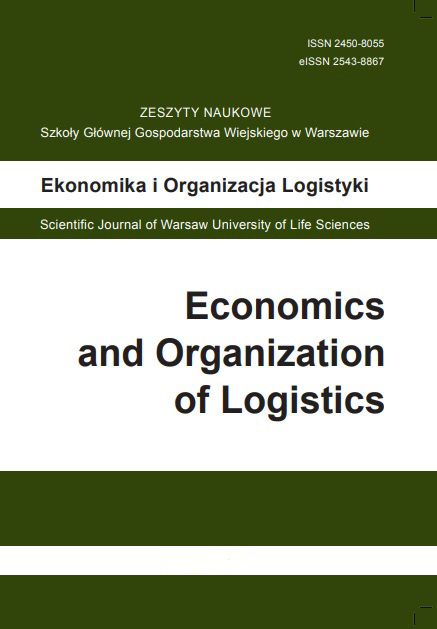Main Article Content
Article Details
Armstrong C.E., Shimizu K., 2007: A review of approaches to empirical research on the resource-based view of the firm, Journal of Management 33(6), 959–986. (Crossref)
Arthanari T., Carfě D., Musolino F., 2015: Game theoretic modeling of horizontal supply chain coopetition among growers, International Game Theory Review 17(02), 1540013. (Crossref)
Balza-Franco V., Paternina-Arboleda C.D., Cantillo V., Macea L.F., Ramírez-Ríos D.G., 2017: A collaborative supply chain model for non-for-profit networks based on cooperative game theory, International Journal of Logistics Systems and Management 26(4), 475–496. (Crossref)
Bentamar A., Taj K., Ourahou O., 2021: Resource-Based Approaches: A Framework for Analyzing Competitiveness in the Context of Reverse Logistics, European Scientific Journal 17(19), 194–207. (Crossref)
Chen T., Wu S., Yang J., Cong G., 2019: Risk propagation model and its simulation of emergency logistics network based on material reliability, International Journal of Environmental Research and Public Health 16(23), 4677. (Crossref)
Coase Ronald H., 1937: The Nature of the Firm, Coase Ronald H. Economics 4, 386–405. Cruijssen F., Dullaert W., Fleuren H., 2007: Horizontal cooperation in transport and logistics: a literature review, Transportation Journal 46(3), 22–39. (Crossref)
Cui L., Hertz S., 2011: Networks and capabilities as characteristics of logistics firms, Industrial Marketing Management 40(6), 1004–1011. (Crossref)
Defryn C., 2017: Models for operational optimisation in a horizontal logistic cooperation: gain sharing, incentives and multi-level objectives, University of Antwerp.
Falcone E., Kent J., Fugate B., 2020: Supply chain technologies, interorganizational network and firm performance: A case study of Alibaba Group and Cainiao, International Journal of Physical Distribution & Logistics Management 50(3), 333–354. (Crossref)
Ferrell W., Ellis K., Kaminsky P., Rainwater C., 2020: Horizontal collaboration: opportunities for improved logistics planning, International Journal of Production Research 58(14), 4267–4284. (Crossref)
Fine C.H., 2003: Clockspeed: Winning industry control in the age of temporary advantage, Perseus Books, Cambridge, MA.
Ford D., (ed.), 1990: Understanding Business Markets: Interaction, Relationships, Academic Press, Londyn.
Gancarczyk M., 2011: Determinanty wyboru strategii z perspektywy teorii kosztów transakcyjnych, Zeszyty Naukowe Uniwersytetu Ekonomicznego w Poznaniu (170), 39–49.
Guajardo M., Rönnqvist M., 2016: A review on cost allocation methods in collaborative transportation, International Transactions in Operational Research 23(3), 371–392. (Crossref)
Hacardiaux T., Tancrez J.S., 2020: Assessing the environmental benefits of horizontal cooperation using a location-inventory model, Central European Journal of Operations Research 28(4), 1363–1387. (Crossref)
Halldorsson A., Kotzab H., Mikkola J.H., Skjřtt‐Larsen T., 2007: Complementary theories to supply chain management, Supply chain management: An International Journal 12(4), 284–296. (Crossref)
Hearnshaw E.J., Wilson M.M., 2013: A complex network approach to supply chain network theory, International Journal of Operations & Production Management 33(4), 442–469. (Crossref)
Hobbs J.E., 1996: A transaction cost approach to supply chain management, Supply Chain Management: An International Journal 1(2), 15–27. (Crossref)
Huo B., Ye Y., Zhao X., Wei J., Hua, Z., 2018: Environmental uncertainty, specific assets, and opportunism in 3PL relationships: A transaction cost economics perspective, International Journal of Production Economics 203, 154–163. (Crossref)
Jouida S.B., Krichen S., Klibi, W., 2017: Coalition-formation problem for sourcing contract design in supply networks, European Journal of Operational Research 257(2), 539–558. (Crossref)
Käkelä L., 2019: Forest entrepreneurs’ willingness to collaborate: a resource-based view. School of Business and Management, Lappeenranta-Lahti University of Technology [praca magisterska].
Karanja P.N., Mairura C.J., Ombui K., 2015: Determinants of effective logistics coordination among humanitarian organizations in Kenya. A case of humanitarian organization in Nairobi County, International Journal of Scientific and Research Publications 5(6), 59–81.
Koh B.H., Wong W.P., Tang C.F., Lim M.K., 2018: The double-edge resource-based view of logistics performance and governance in Asian countries, Asia Pacific Journal of Marketing and Logistics 30(3), 652–668. (Crossref)
Krajewska M.A., Kopfer H., Laporte G., Ropke S., Zaccour G., 2008: Horizontal cooperation among freight carriers: request allocation and profit sharing, Journal of the Operational Research Society 59, 1483–1491. (Crossref)
Lai F., Li D., Wang Q., Zhao X., 2008: The information technology capability of third‐party logistics providers: a resource‐based view and empirical evidence from China, Journal of Supply Chain Management 44(3), 22–38. (Crossref)
Lai K.H., 2004: Service capability and performance of logistics service providers, Transportation Research Part E: Logistics and Transportation Review 40(5), 385–399. (Crossref)
Lee E.S., 2016: Knowledge Sharing within an Intermodal Logistics Network and Logistics Performance, Journal of International Trade & Commerce 12(4), 37–51. (Crossref)
Leitner R., Meizer F., Prochazka M., Sihn W., 2011: Structural concepts for horizontal cooperation to increase efficiency in logistics, CIRP Journal of Manufacturing Science and Technology 4(3), 332–337. (Crossref)
Lozano S., Moreno P., Adenso-Díaz B., Algaba E., 2013: Cooperative game theory approach to allocating benefits of horizontal cooperation, European Journal of Operational Research 229(2), 444–452. (Crossref)
Luo C., Zhou X., Lev B., 2022: Core, Shapley value, nucleolus, and Nash bargaining solution: A Survey of recent developments and applications in operations management, Omega 110, 102638. (Crossref)
Łupicka A., 2005: Teorie wyjaśniające powstawanie i funkcjonowanie sieci logistycznych, LogForum, 1(2), 1.
Martin N., Verdonck L., Caris A., Depaire B., 2018: Horizontal collaboration in logistics: decision framework and typology, Operations Management Research 11, 32–50. (Crossref)
Mason R., Lalwani C., Boughton R., 2007: Combining vertical and horizontal collaboration for transport optimization, Supply Chain Management: An International Journal 12(3), 187–199. (Crossref)
Morash E.A., Lynch D.F., 2002: Public policy and global supply chain capabilities and performance: a resource-based view, Journal of International Marketing 10(1), 25–51. (Crossref)
Moro Visconti R., 2019: Combining network theory with corporate governance: Converging models for connected stakeholders, Corporate Ownership & Control, 17(1), 1–15. (Crossref)
Moro Visconti R., 2020: Corporate governance, digital platforms, and network theory: Information and risk-return sharing of connected stakeholders, Corporate Governance, Digital Platforms, and Network Theory: Information and Risk-Return Sharing of Connected Stakeholders, 179–204. (Crossref)
Nath P., Nachiappan S., Ramanathan R., 2010: The impact of marketing capability, operations capability and diversification strategy on performance: A resource-based view, Industrial Marketing Management 39(2), 317–329. (Crossref)
Nelson R., Winter S., 1982: An evolutionary theory of the firm, Harvard University Press, Cambridge.
Newbert S.L., 2007: Empirical research on the resource‐based view of the firm: an assessment and suggestions for future research, Strategic Management Journal 28(2), 121–146. (Crossref)
Oerlemans L.A., Meeus M.T., 2001: R&D cooperation in a transaction cost perspective, Review of Industrial Organization 18, 77–90. (Crossref)
Olavarrieta S., Ellinger A.E., 1997: Resource‐based theory and strategic logistics research, International Journal of Physical Distribution & Logistics Management 27(9/10), 559–587. (Crossref)
Özbađ G.K., Arslan O., 2020: A Resource-Based Theory Perspective of Logistics, [in:] Ç.C. Gökçe (ed.) Handbook of Research on the Applications of International Transportation and Lo- gistics for World Trade, IGI Global, , 195–209. (Crossref)
Peng M.W., Wang DY., Jiang Y., 2008: An institution-based view of international business strategy: A focus on emerging economies, Journal of International Business Studies 39, 920–936. (Crossref)
Piboonrungroj P., Disney S.M., 2015: Supply chain collaboration in tourism: a transaction cost economics analysis, International Journal of Supply Chain Management 4(3), 25–31.
Pomponi F., Fratocchi L., Tafuri S.R., 2015: Trust development and horizontal collaboration in logistics: A theory based evolutionary framework, Supply Chain Management: An International Journal 20(1), 83–97. (Crossref)
Pomponi F., Fratocchi L., Tafuri S.R., Palumbo M., 2013: Horizontal collaboration in logistics: a comprehensive framework, Research in Logistics & Production 3, 243–254.
Prataviera L.B., Creazza A., Dallari F., Melacini M., 2023: How can logistics service providers foster supply chain collaboration in logistics triads? Insights from the Italian grocery industry, Supply Chain Management: An International Journal 28(2), 242–261. (Crossref)
Provan K.G., Kenis P., 2008: Modes of network governance: Structure, management, and effectiveness, Journal of Public Administration Research and Theory 18(2), 229–252. (Crossref)
Reyes P.M., 2005: Logistics networks: A game theory application for solving the transshipment problem, Applied mathematics and computation 168(2), 1419–1431. (Crossref)
Salge T.O., Piening E.P., Foege N., 2013: Exploring the Dark Side of Innovation Collaboration: A Resource-Based Perspective, Academy of Management Proceedings 1, 12061. (Crossref)
Schulz S.F., Blecken A., 2010: Horizontal cooperation in disaster relief logistics: benefits and impediments, International Journal of Physical Distribution & Logistics Management 40(8/9), 636–656. (Crossref)
Simatupang T.M., Sridharan R., 2002: The collaborative supply chain, The International Journal of Logistics Management 13(1), 15–30. (Crossref)
Singh H., Garg R., Sachdeva A., 2018: Supply chain collaboration: A state-of-the-art literature review Uncertain Supply Chain Management 6(2), 149–180. (Crossref)
Skjřtt‐Larsen T., 2000: Third party logistics–from an interorganizational point of view, International Journal of Physical Distribution & Logistics Management 30(2), 112–127. (Crossref)
Stank T.P., Davis B.R., Fugate B.S., 2005: A strategic framework for supply chain oriented logistics, Journal of Business Logistics 26(2), 27–46. (Crossref)
The impact of WMS implementation on work productivity. The case of three distribution warehouses. Scientific Journal of Warsaw University of Life Science Economics and Organization of Logistics, 5(3), 77–91. https://doi.org/10.22630/EIOL.2020.5.3.23 (Crossref)
Toyasaki F., Arikan E., Silbermayr L., Falagara Sigala I., 2017: Disaster relief inventory management: Horizontal cooperation between humanitarian organizations, Production and Operations Management 26(6), 1221–1237. (Crossref)
Vanovermeire C., Sörensen K., Van Breedam A., Vannieuwenhuyse B., Verstrepen S., 2014: Horizontal logistics collaboration: decreasing costs through flexibility and an adequate cost allocation strategy, International Journal of Logistics Research and Applications 17(4), 339–355. (Crossref)
Verdonck L., Beullens P., Caris A., Ramaekers K., Janssens G. K., 2016: Analysis of collaborative savings and cost allocation techniques for the cooperative carrier facility location problem, Journal of the Operational Research Society 67, 853–871. (Crossref)
Verstrepen S., Cools M., Cruijssen F., Dullaert W., 2009: A dynamic framework for managing horizontal cooperation in logistics, International Journal of Logistics Systems and Management 5(3–4), 228–248. (Crossref)
Visser E.J., 2007: Logistic innovation in global supply chains: an empirical test of dynamic transaction-cost theory, GeoJournal 70(2–3), 213–226. (Crossref)
Wang Y., Peng S., Xu M., 2021: Emergency logistics network design based on space–time resource configuration, Knowledge-Based Systems 223, 107041. (Crossref)
Williamson O.E., 2008: Outsourcing: Transaction cost economics and supply chain management, Journal of Supply Chain Management 44(2), 5–16. (Crossref)
Williamson O.E., 2010: Transaction cost economics: The natural progression, American Economic Review 100(3), 673–690. (Crossref)
Wong C.Y., Karia N., 2010: Explaining the competitive advantage of logistics service providers: A resource-based view approach, International Journal of Production Economics 128(1), 51–67. (Crossref)
Wu F., Yeniyurt S., Kim D., Cavusgil S.T., 2006: The impact of information technology on supply chain capabilities and firm performance: A resource-based view, Industrial Marketing Management 35(4), 493–504 (Crossref)
Xu N.R., Liu J.B., Li D.X., Wang, J., 2016: Research on evolutionary mechanism of agile supply chain network via complex network theory, Mathematical Problems in engineering. (Crossref)
Xu X., 2013: Collaboration mechanism in the horizontal logistics collaboration, Doctoral dissertation, Ecole Nationale Supérieure des Mines de Paris, Paris.
Xu X., Pan S., Ballot E., 2012, August: Game theoretic contribution to horizontal cooperation in: 4th International Conference on Information Systems, Logistics And Supply Chain-ILS 2012, 10.
Yang C.C., Marlow P.B., Lu C.S., 2009: Assessing resources, logistics service capabilities, innovation capabilities and the performance of container shipping services in Taiwan. International Journal of Production Economics, 122(1), 4–20. (Crossref)
Zhang C., Dhaliwal J., 2009: An investigation of resource-based and institutional theoretic factors in technology adoption for operations and supply chain management, International Journal of Production Economics 120(1), 252–269. (Crossref)
Zhang J., 2023: Research on the Evolution of Technological Innovation Network in China’s Logistics Industry, International Journal of Education and Humanities 8(2), 189–198. (Crossref)
Downloads
- Anna Czarny, Efektywność w gospodarce zapasami w przedsiębiorstwach przetwórstwa przemysłowego na tle pandemii COVID-19 , Ekonomika i Organizacja Logistyki: Tom 9 Nr 1 (2024)
Możesz również Rozpocznij zaawansowane wyszukiwanie podobieństw dla tego artykułu.

Utwór dostępny jest na licencji Creative Commons Uznanie autorstwa – Użycie niekomercyjne 4.0 Międzynarodowe.





